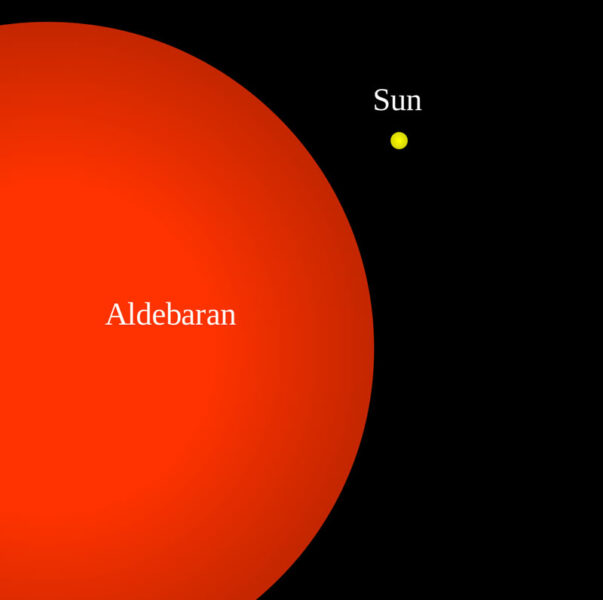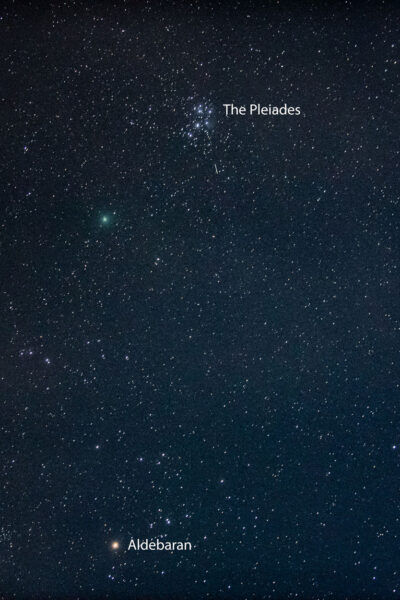Learn more about Aldebaran, the red-orange giant star that “follows” the Pleiades across the sky.
Vital Aldebaran Stats
| Official name (IAU-approved) | Aldebaran ("The Follower" in Arabic) |
| Other designations | Alpha, Tauri, HR 1457, HIP 21421 |
| Nicknames | -- |
| Apparent magnitude | 0.86 |
| Distance from Earth | 66.5 light-years |
| Type | Red giant, K5 III |
| Color | Red/orange |
| Mass | 1.16 M☉ |
| Radius | 44 R☉ |
| Constellation | Taurus |
| Right ascension | 4h 35m 55s |
| Declination | +16° 30' 33” |
| Multiple system? | Possibly |
| Variable star? | Yes |
| Exoplanet status | One suspected gas giant |
| Probable fate | Planetary nebula/white dwarf |
Physical Characteristics

Mysid / Wikimedia Commons
Aldebaran, the brightest star in the constellation Taurus, is an excellent example of a red giant star. Red giants are interesting objects for a couple of reasons. Unlike the Sun, which fuses hydrogen in its core to support itself against gravity, a red giant like Aldebaran has used up these reserves and instead fuses hydrogen in a shell around the inert helium core.
As the quiet core continues to contract, this hydrogen envelope swells, causing the star’s outer shell to expand magnificently. Aldebaran has expanded to span 44 times the Sun’s diameter. But amazingly, their mass is roughly the same — so Aldebaran’s outer hydrogen shell is much more rarefied than the Sun’s. A side effect of this expansion is an accompanying increase in the red giant’s luminosity, and Aldebaran shines with the power of at least 450 Suns.
But perhaps the most interesting attribute of this star — and certainly the most obvious from Earth’s perspective — is its temperature, which gives the giant its color. Just because it’s red doesn’t mean it’s hotter; in fact, the opposite is true. Red giants are relatively cool stars, and Aldebaran is no exception. While the surface of the Sun is about 5,500°C (10,000°F), Aldebaran is considerably cooler at 3,700°C. To observe Aldebaran’s color, compare its reddish glow to other stars nearby, such as blue Rigel in Orion, or white-yellow Capella in Auriga.
Aldebaran could be a multiple star system. The star has five companions in the sky, far smaller than Aldebaran and woefully dim by comparison, and one of these appears to orbit the star, based on data from the European Space Agency’s Gaia satellite. Aldebaran is also the possible host star of a massive exoplanet, Aldebaran b. If it exists, the planet would be about 6 times larger than Jupiter, but it’s possible that stellar activity mimics the planetary signal.
Origin / Mythology

S&T / IAU
The name Aldebaran comes from al Dabaran from Arabic, meaning “The Follower.” The name might stem from the fact that Aldebaran rises behind the Pleiades, “following” them through the sky.
Located in the constellation Taurus, the Bull, Aldebaran is often visualized as the bull’s eye. Taurus is a very old constellation, with bovine associations reaching back to Gilgamesh-era Mesopotamia, about 4,000 years ago. Taurus might even be the large bull depicted in the ancient cave paintings at Lascaux, France. Artists often depict Taurus as just the front half of the animal, though.
The ancient Greeks, Egyptians, Babylonians, and Romans, all shared the concept of Taurus the Bull, though in some Native American cultures, Taurus was the head of a bison rather than a bull. Far to the north, the Inuit people of the Arctic saw Aldebaran as a polar bear. Taurus seems to be charging eastward toward Orion, who looks poised to defend himself, and indeed, this drama plays out in some myths.

Daniel Johnson
At a more practical level, the heliacal rising of Taurus — particularly the Pleiades — also served as a sign of spring to the ancients, though the precession of Earth’s axis means that’s no longer the case.
Aldebaran is a variable star, with a subtle 0.25-magnitude change in brightness over a long period, which Aboriginal Australians may have recorded in their oral traditions.
In more recent “mythology,” the now-inoperative Pioneer 10 probe is on a trajectory that — assuming no disturbances — will pass near Aldebaran millions of years in the future.
How to See Aldebaran

Daniel Johnson
As it’s about the 14th-brightest star in the night sky, Aldebaran is easy to find once you’re in the right region of the sky. The obvious reddish hue is also a great clue. But perhaps the best aid to help you locate Aldebaran is its proximity halfway between two major and recognizable objects: the constellation Orion and the Pleiades star cluster. The three-star line of Orion’s belt also points roughly in Aldebaran’s direction, although the alignment isn’t exact.
Aldebaran is also something of an honorary member of the Hyades star cluster, as it appears to sit in the middle from our point of view. But it’s only a line-of-sight effect since Aldebaran is actually closer than halfway to the Hyades.
If you’re looking for a deep-sky jaunt, a short jump from Aldebaran will bring your telescope to the famous Crab Nebula, the remains of a supernova that exploded in 1054 AD.
As Aldebaran is located near the ecliptic, the star enjoys frequent (in astronomical terms) conjunctions and occultations with the Moon and planets. When it pairs up with a solar system world, the scene makes for an excellent photo opportunity. And where should you point your camera? Just aim for that big red “bull’s eye!”
Daniel Johnson is a Wisconsin-based freelance writer and professional photographer and the co-author of over a dozen books. He’s a longtime amateur astronomer and fortunate enough to live in a rural region with excellent seeing conditions. You can view some of Dan’s photography (he does a lot of animals!) at www.foxhillphoto.com
 3
3









Comments
Andrew James
December 24, 2020 at 4:47 pm
Since a youngster, I've always liked the story that Aldebaran is said to be the blood procured from nearby Orion the Hunter, after Taurus had charged at him and pierced his flesh.
You must be logged in to post a comment.
Andrew James
December 24, 2020 at 5:06 pm
An occultation of Aldebaran was seen to the naked-eye by Copernicus in March 1497.
You must be logged in to post a comment.
Andrew James
December 24, 2020 at 5:09 pm
Johnson (1885) wrote an occultation was first seen in Athens, Greece on 11th March 509 AD
You must be logged in to post a comment.
You must be logged in to post a comment.